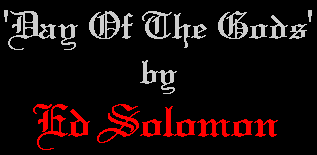
lecture22 solomon

|
Introduction. Back in 1996 when the Altar Flame was burning brightly, Volume four, Issue four was essentially mine. It the work there was one of my early Egyptian pieces called the Day of the Gods. As I am now close to publication of the Egyptian Magic book I have been posting some Egyptian material as samples of what can be expected. Several things were not included in the book so I am passing them along for those who might enjoy tasting the wine before its bottled. I will paraphrase the story here but you might look it up if you have saved all your copies of the Altar Flame (the issue mentioned also contains a full size version of the cartouche required).
Story: Back in 1924 E.A.Wallis Budge, the keeper of Egyptian and Assyrian Antiquities in the British Museum, published two volumes on the gods of the Egyptians. His fascination with the gods led him to explore the greater and the lesser gods from the earliest dynasties through the waning years of that great civilization. The common Egyptian was not schooled in the ways of the priesthood and had to rely on the priests to keep them informed about the gods and the festivals set aside for the proper deity. DeNomolos owns a copy of the papyrus that Budge discovered and presents it in the following manner. Because there were so many gods it was difficult to know which one was to be worshiped at what time of the year. After the Heretic Akhenaten was deposed or disposed of as the case may be, the priest dug up all the statues of the old gods and re-established the old religion. Akhenaten, also known as Amenhotep III, had tried to change the religion of Egypt to a one god system and his own personal god was Ra, the sun god. This new order of things almost put the priesthood out of business so it was necessary to oppose him and eventually remove him from the throne of Egypt. Anyway, the papyrus that DeNomolos exhibited showed a group of gods along the perimeter of an oval cartouche with a set of footprints spiraling out from the center. "The goal of every Egyptian was to be rewarded with a reunion with the gods in the afterlife. The foot prints show the way through the sands of time. By paying the priest a small fee the commoner was led on the path to the selected god." The people were told to select a number between five, the number of extra days added to the Egyptian calendar each year and 15, the dynasty when this unique test was so prevalent. Using a small scarab amulet we walk to the number you selected. Walk into the circle of gods and move counter clockwise until you reach your number then move back clockwise again to your other number. The location is the god de jure. The direction you take and the number of steps will lead you to everlasting life. Please pay the priest on the way out. A prediction is used to insure that the path was well chosen and the story can be adjusted to fit the time and place of the performance and the mood of the audience. Working: Immediately recognizable is the old "Q" force. The tail is of course on the inside of the circle and is hidden as footprints. Self working, the scarab can be moved by the spectator if careful instruction are given. Because of the Egyptian theme, the gods in the cartouche and the use of the scarab amulet, the obvious is disguised from the scrutiny of even many who know the old force.
Another version of this will appear in the Book Of Egyptian Magic. In The
Craft, |
| All the material in this lecture is copyrighted with all rights reserved to Ed Solomon, 2002. |